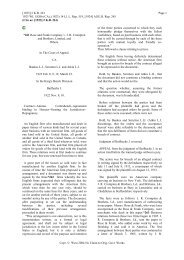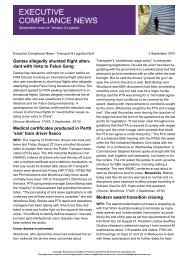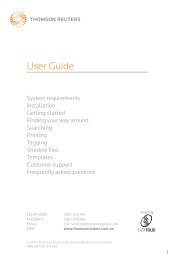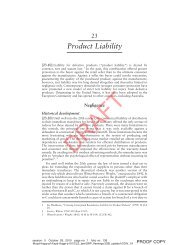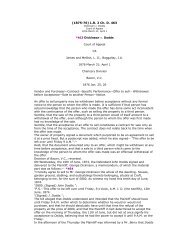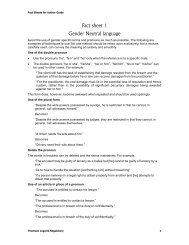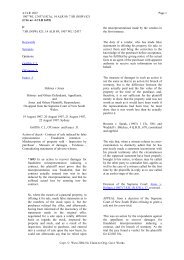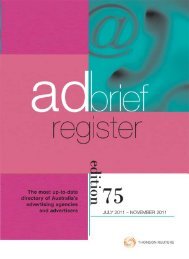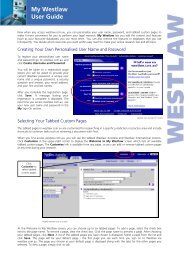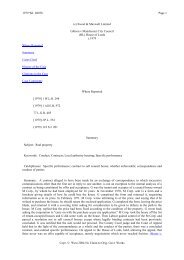Tesco v Constain - Thomson Reuters
Tesco v Constain - Thomson Reuters
Tesco v Constain - Thomson Reuters
Create successful ePaper yourself
Turn your PDF publications into a flip-book with our unique Google optimized e-Paper software.
2003 WL 21729349 Page 532003 WL 21729349 (QBD (T&CC)), [2003] EWHC 1487(Publication page references are not available for this document.)The Costain 1989-1990 Tortious Duties Issues202. In the light of the submissions of Counsel, itis plain that the real question to which these issuesgive rise, notwithstanding the terms of Issue 7, isnot whether Costain owed any duty of care to<strong>Tesco</strong> at all in relation to the work which it did inconnection with the construction of the Store in1989 and 1990, but what were the nature and scopeof that duty of care. Before coming to consider indetail the relevant authorities and applicableprinciples it is, perhaps, helpful to remind oneselfof the essential features of this case from Costain'spoint of view. The basis of the claim in tort againstit is that it owed a duty of care to <strong>Tesco</strong> to exercisereasonable skill and care in the design andconstruction of the Store, in particular to includeappropriate fire stopping and inhibiting measures inthe structure. Costain's main answer to thatallegation is that it did not itself make the relevantdesign decisions in relation to fire stopping andinhibiting measures, PHJ did. <strong>Tesco</strong>'s counter tothat answer is, in essence, that Costain assumedresponsibility by contract for the adequacy of thedesign of the Store, and it therefore owed a duty ofcare in respect of the design which mirrored itscontractual obligations. However that may be, andit is a point to which I shall return, the allegeddeficiencies in design did not themselves cause anydamage to anything. Rather they meant thatdamage in fact caused quite independently ofCostain or any work it did, namely by the firewhich broke out on 4 August 2001, was moreextensive than it would have been, so it iscontended, if appropriate fire stopping andinhibiting measures had been in place in the Store.In consequence not only was the Store itselfdamaged severely, but the contents of the Store, inthe form of stock and plant and machinery, weredamaged, as was an extension to the Storeconstructed in 1997. Moreover, <strong>Tesco</strong> lost profits,so it is said, as a result of the Store being unable totrade, or to trade to its normal capacity, for a periodwhilst it was being rebuilt. These features of thecase give rise to a number of important questions ofprinciple.203. The approach which I was urged on behalf of<strong>Tesco</strong> to adopt to questions of the nature and scopeof duties of care, where those matters were raisedby the preliminary issues, was set out in the writtenopening of Mr. Stewart and Mr. Chapman asfollows:--"37. In considering the existence and scope ofthe duties in tort that may be owed, it may berelevant to distinguish between a duty of carelimited to physical damage to property other thanto the store itself ("the Donoghue v. Stevensonduty") and a duty of care founded on an assumptionof responsibility which allows the recovery of"pure" economic loss including damage to "thething itself" ("the Henderson duty").38. The following ought not to be controversial:a. Save for a dispute as to the extent oftheir design responsibilities, PHJ owed <strong>Tesco</strong> aHenderson duty concurrent with and arising fromthe architect's appointment.b. Save for a dispute as to the scope of itsinspection duties, Costain owed <strong>Tesco</strong> a Hendersonduty arising out of the 1993/4 inspections.c. Save for a dispute as to the scope of itsdesign duties, Costain owed <strong>Tesco</strong> (at the veryleast) a Donoghue v. Stevenson duty arising out ofits (design and) construction of the store.39. What is more controversial, and perhaps atthe heart of the present dispute, are the followingissues:a. Whether Costain owed <strong>Tesco</strong> aHenderson duty in respect of the (design and)construction of the store; andb. Whether PHJ, if they are to be treatedas being novated to Costain, owed <strong>Tesco</strong> any dutyof care at all in respect of design and/or inspectionservices provided pursuant to the novation (thoughthis does not fall to be determined now).(2) The Henderson duty40. The following principles arise from theauthorities:a. Where an employer contracts with adesigner for the design of a building, the designerwill owe to the employer a duty of care in tort toexercise reasonable skill and care in and about thedesign.b. The duty of care will be concurrent withthe designer's contractual duties.c. The duty of care will usually extend toholding the employer harmless against economic aswell as physical loss and damage, particularlywhen the designer is under a contractual duty(whether express or implied) to exercise reasonableskill and care in and about the design.d. The duty of care in these circumstancesstems from the proximity between the parties andthe assumption of responsibility on the part of thedesigner for the design. It is based squarely on theline of authorities from Hedley Byrne v. Heller &Partners [1964] AC 465 through Henderson v.Merrett [1995] 2 AC 145.41. Whether the designer is an architect or adesign and build contractor ought not, as a matterof principle, to make any difference: HBellefieldComputer Services Ltd. v. E. Turner & Sons Ltd.[2000] BLR 97 at 102 per Schiemann LJ; HStorey v.Copr. © West 2004 No Claim to Orig. Govt. Works



